- 2.4.15 Command Codes ETXCL, SEQNC, STBLK, PAYMT, PYBAL, VARIA, CRBLK, and TXCTL for Area Office Payment Processing
- 2.4.15.1 Program Scope and Objectives
- 2.4.15.1.1 Background
- 2.4.15.1.2 Authority
- 2.4.15.1.3 Roles and Responsibilities
- 2.4.15.1.4 Program Management and Review
- 2.4.15.1.5 Program Controls
- 2.4.15.1.6 Terms and Acronyms
- 2.4.15.1.7 Related Resources
- 2.4.15.1.8 Definition of Common terms for Area Office Payment Processing
- 2.4.15.1.9 Overview of Terminal Input of Payments
- 2.4.15.1.10 Posting Items to the Next Day's Deposit
- 2.4.15.1.11 Recovery of Data in Event of Breakdown
- 2.4.15.1.12 General Error Messages
- 2.4.15.2 Command Code ETXCL
- 2.4.15.2.1 Terminal Responses for CC ETXCL
- 2.4.15.3 Command Code SEQNC
- 2.4.15.3.1 Terminal Response for CC SEQNC
- 2.4.15.4 Command Code STBLK
- 2.4.15.4.1 Terminal Responses for CC STBLK
- 2.4.15.5 Command Code PAYMT
- 2.4.15.5.1 Terminal Responses for CC PAYMT
- 2.4.15.5.1.1 PAYMT CFOL Error Response
- 2.4.15.5.1 Terminal Responses for CC PAYMT
- 2.4.15.6 Command Code PYBAL
- 2.4.15.6.1 Terminal Responses for CC PYBAL
- 2.4.15.7 Command Code VARIA
- 2.4.15.7.1 Terminal Responses for CC VARIA
- 2.4.15.8 Command Code CRBLK
- 2.4.15.8.1 Terminal Responses for CRBLK
- 2.4.15.9 Command Code TXCTL
- 2.4.15.9.1 Terminal Responses for CC TXCTL
- Exhibit 2.4.15-1 CC ETXCL Request Displays to Re-establish Cumulative Amounts of Previously Input
- Exhibit 2.4.15-2 CC ETXCL Request Display to Set Terminal Tax Counters at Zero
- Exhibit 2.4.15-3 CC SEQNC Request Display
- Exhibit 2.4.15-4 CC SEQNC Response Display
- Exhibit 2.4.15-5 CC STBLK Input Display
- Exhibit 2.4.15-6 CC PAYMT Input Display
- Exhibit 2.4.15-7 CC PAYMT Input Display
- Exhibit 2.4.15-8 CC PAYMT Input Display
- Exhibit 2.4.15-9 CC PAYMT Input Display
- Exhibit 2.4.15-10 CC PAYMT Input Display
- Exhibit 2.4.15-11 CC PAYMT Output Display
- Exhibit 2.4.15-12 CC PAYMT Output Display — CC PYBAL Format
- 2.4.15.1 Program Scope and Objectives
Part 2. Information Technology
Chapter 4. IDRS Terminal Input
Section 15. Command Codes ETXCL, SEQNC, STBLK, PAYMT, PYBAL, VARIA, CRBLK, and TXCTL for Area Office Payment Processing
2.4.15 Command Codes ETXCL, SEQNC, STBLK, PAYMT, PYBAL, VARIA, CRBLK, and TXCTL for Area Office Payment Processing
Manual Transmittal
May 15, 2025
Purpose
(1) This transmits revised IRM 2.4.15, IDRS Terminal Input, Command Codes ETXCL, SEQNC, STBLK, PAYMT, PYBAL, VARIA, CRBLK, and TXCTL for Area Office Payment Processing.
Material Changes
(1) Audience: This IRM has been revised to change all instances of Wage & Investment (W&I) to Taxpayer Services (TS)
(2) IRM 2.4.15.1 Program Scope and Objectives: Mandatory internal controls revised to comply with standard updates
Effect on Other Documents
IRM 2.4.15, dated November 15, 2022, is superseded.Audience
LB&I, SB/SE, TE/GE, TS, TAS.Effective Date
(05-15-2025)
Rajiv Uppal
Chief Information Officer
-
This IRM section provides the instructions for the use of PAYMT.
-
Purpose :These section provides instructions for inputting Command Codes ETXCL, SEQNC, STBLK, PAYMT, PYBAL, VARIA, CRBLK, and TXCTL for Area Office Payment Processing .
-
Audience: IRS Tax Technicians and Account Management employees.
-
Policy Owner: The Director, Small Business Self Employed (SB/SE) owns the policies contained herein.
-
Program Owner: Small Business Self Employed (SB/SE) is responsible for the administration, procedures, and updates related to the program.
-
Primary Stakeholders: Small Business Self-Employed (SB/SE)
-
Program Goals: These are the instructions for using the PAYMT IDRS command codes.
-
This IRM and the contained sections provide the user the necessary information on how to use the command code ETXCL, SEQNC, STBLK, PAYMT, PYBAL, VARIA, CRBLK, and TXCTL.
-
The command code ETXCL, SEQNC, STBLK, PAYMT, PYBAL, VARIA, CRBLK, and TXCTL was developed as a means of taxpayer’s manual payments.
-
EOD Project Lead is responsible for
-
Review and implementation of WRs that affect PAYMT
-
Updating the contents of this IRM
-
-
Program Reports:Quality Review reports are available in CONTROL-D via the EOD07
-
Program Effectiveness:Able for online PAYMT
-
The table lists commonly used acronyms and their definitions:
Word or acronym: Meaning: Example of use: BMF Business Master File Corporate Account Data Stores CC Command Code The use of CC has sped up processing time. EIN Employer Identification Number The business Taxpayer identifier is called an EIN. IDRS Integrated Data Retrieval System IDRS only contains accounts being worked on, not all accounts the IRS maintains. IMF Individual Master File Corporate Account Data Stores MFT Master File Tax (code) The Taxpayer used Form 1040 which is MFT-30. TIN Taxpayer Identification Number A TIN can be a SSN or EIN.
-
The following is the primary source of guidance on the Command Codes ETXCL, SEQNC, STBLK, PAYMT, PYBAL, VARIA, CRBLK, and TXCTL program.
-
IRM 2.4.15, IDRS Terminal Input, Command Codes ETXCL, SEQNC, STBLK, PAYMT, PYBAL, VARIA, CRBLK, and TXCTL
-
-
Terminal Hold Areas—Temporary data storage areas within the system where input remittance data is held until input blocks of remittances have been successfully completed and balanced. Data in the hold areas can be corrected, added to or deleted until the block is balanced, after which the input remittances will be automatically released for end-of-day processing and the hold areas will be cleared for input of the next block.
-
Tax Class Counters—A set of counters, which accumulate the money amounts input to each True Tax Class. The counters are maintained so that total amounts input for each tax class may be called up and printed for use in preparing the Certificate of Deposit. The counters are added to only when a balanced input block is released. The counters are reset every time CC ETXCL is input and are set to the amount input with CC ETXCL (if no amount is input for a specific tax class that counter is set to zero).
-
Payment Sequence Number—A 13-digit number that must be established in the terminal after the Tax Class Counters are set and prior to input of remittances. CC SEQNC establishes the number and provides the three digit Julian Date and 3 digit Sequence Number portion of the Payment Sequence Number, the remainder of which is generated from terminal and employee number data. The 3 digit Sequence Number when input will always be for the next PAYMT to be input. After CC SEQNC is used to establish or update it, the terminal maintains the Payment Sequence Number. It will assign the number to each PAYMT and then increment the number by one to create a unique number for the next payment. The Payment Sequence Number carries information used in constructing the True DLN of the payment, in preparing the Area Office Remittance Register, and in building a research and Audit trail unique to each remittance.
-
Deposit Day —The Tax Class Counters and Payment Sequence Numbers are maintained for remittances to be included on the CD deposited on a specific date. The Deposit Day begins when the first remittance is input for a specific deposit date and ends with completion of the last input block of remittances for that deposit date. The Deposit Day may begin on the morning of day of deposit, or on the afternoon of the previous workday (PM input).
. -
NON-IDRS Indicator—This field specifies the IDRS condition of the tax module to which a remittance is being directed. Unless prior research has been undertaken, all tax modules will be presumed to be present on IDRS. If the taxpayer's account or module is not on IDRS, upon receiving the error message response the terminal operator will verify that all data has been entered correctly from the source document. If the source document is not a printed IRS notice or other IRS form, tax account research may be undertaken if necessary to determine correct TIN, name control, type of tax or period, in order to insure a correct posting.
-
Block Balancing—This feature assures correct input of remittance amounts. The money total (from an adding machine tape of remittance amounts) for an input block is entered with CC STBLK. When all items in the block are complete, the STBLK amount is automatically compared to an accumulated total of all item amounts. If the totals do not agree, an error response is given and the out-of-balance condition must be corrected before the input block will be released.
-
Transaction Codes—This field used to identify a transaction being processed and to maintain a history of actions posted to a taxpayer's account on the Master File.
-
MFT Codes—The MFT codes are required in each transaction to identify the specific module to which a transaction is to be posted.
-
Blocks will be received which consist of remittances, related posting documents, and an adding machine tape showing the total value of remittances and the number of input items in the block.
-
The first action for each Deposit Day will be input of CC ETXCL. This will set the terminal tax counters at zero, in order to begin a cumulative count of payment amounts by class of tax for the day's deposit. A provision is provided for amounts to be input to reset these counters to the correct amount in case of power failure, terminal realignment overnight, etc. Normally, CC ETXCL need be used only once for each deposit day.
-
This command code wipes out the Payment Sequence Number and any data in STBLK and Payment Hold Areas.
-
The next action after input of CC ETXCL will be input of CC SEQNC to establish a Payment Sequence Number for the terminal. CC SEQNC is also required if a different operator inputs payments at the same terminal, in order to update the operator number in the Payment Sequence Number. The operator should verify the days/dates on the screen after CC SEQNC is input.
-
CC STBLK is used to begin input of the block of payments and establish document count and total amount for the block and set the Transaction Register Indicator. Satisfactory entry will result in generated display of CC PAYMT. Taxpayer entities that are either "dummy" entities or not present on the TIF are validity checked against the NAP files. Additional validation checks will be done for IMF and BMF dummy modules by accessing CFOL. As each payment is posted correctly, entry will result in a response display of the payment input Command Code PAYMT, and a 13-digit Payment Sequence Number. The number is stamped on the remittance relating to the posting just entered and on the source document or posting voucher. Input the next payment and subsequent remittance item until the block is completed.
-
Upon satisfactory entry of the final payment in the block, the response display will show CC PYBAL and last payment's Payment Sequence Number. When the ENTER key is depressed after input of entry code, the response for a block in balance (the computer's accumulated block document count and amount is equal to block document count and the amount input with CC STBLK when block was begun) is a display of PAYMENTS. The display "PAYMENTS" is followed by the block count, the amount, the beginning sequence number, the ending sequence number and cumulative totals by true tax classes. (These totals are cumulative for the terminal, identical to those displayed with TXCTL). Print out each balanced block by depressing the PRINT key. If a block is out of balance, provisions have been made to make necessary corrections. See VARIANCE and VARIA.
-
If need arises to change the number of items or the amount for the block, command code CRBLK is used. Both the number of items and the block amount must be entered, even if only one field is being corrected. The Transaction Register Indicator may also be corrected with this command code.
-
Command Code TXCTL is used to obtain the cumulative tax class totals for all blocks input through a terminal at the end of each day's posting. These totals are printed and adding machine tape run for all terminals inputting payment blocks. The consolidated totals will be used in preparing the deposit documents.
-
If volume requires, payments may be input for the next day's deposit after the cutoff time for the current deposit date. Use CC ETXCL and CC SEQNC to set counters and establishes a Payment Sequence Number for new Julian Deposit Date. Begin input of a block only if it could be completed before the close of business. Key in command code TXCTL after the last block is balanced before the close of business. Print a copy of the tax class totals. Attach the tax class totals print to the terminal. Before continuing input for that deposit on the next workday, input TXCTL and compare the screen display with the print made at the end of the previous workday. If they are not identical in all respects, use ETXCL and SEQNC to re-establish the totals as shown on the previous workday's TXCTL print and to establish the next Payment Sequence Number. The tax class totals and last Payment Sequence Number may also be found on the PAYMENTS display of the last block input on the previous workday. If TXCTL print and display agree, input STBLK and continue the day's deposit.
-
If a terminal or the system should break down while a block is in process, the action required would depend on how long it is expected to take to become operational again.
-
If a single terminal is involved and it is not expected to become operational in time to complete the day's deposit actions: Reprocess the block which was Terminal. Renumber the related remittances when input at the new terminal. When the malfunction is corrected, delete the partially completed block in the old terminal.
-
If the system is down and not expected to be operational in time to complete the day's deposit actions, request instructions for completion of the deposit from supervisor. When the malfunction is corrected, it will be necessary to determine if any of the input data has been lost. Use command code TXCTL to determine the Payment Sequence Number of the last payment included in the cumulative tax class totals. Re-input any missing items and renumber the related remittances.
-
TIP ERROR OCCURRED—unable to access TIP FILE due to input/output error.
-
CHANGE IN TERM AREAS-ETXCL REQUIRED—TERMINAL-ID does not match the terminal-id which was already input. ETXCL must be input to re-set the TERMINAL-ID.
-
ROUTED TO WRONG RTAP-NOTIFY RPA—an attempt was made to input an invalid command code. The command code input does not match one of the 8 valid command codes for the Area Office Payments program.
-
This command code is used to establish terminal tax class counters or to set terminal tax class counters at zero to begin a cumulative count of payment amounts by class of tax for the day's deposit.
-
Error Response: error messages are displayed with an asterisk immediately following any invalid field. The invalid element on then be corrected and re-entered.
-
Tax Class—must be TCn. The n must be 1–5, 7, or 8 and may not be repeated.
-
Tax Class Amounts—Every TCn must have a corresponding edited money field that is greater than zero. Valid range for an amount field is .01 to 9999,999,999.99.
-
-
Valid Response: A Generated CC SEQNC format is returned for input.
-
This format is used to establish a Payment Sequence Number after using CC ETXCL to set tax class counters to a zero; to reestablish the correct number after using CC ETXCL to reset counters; or to update the operator number in the existing Payment Sequence Number.
-
Error Responses:
-
BLOCK IN PROCESS—Check of STBLK hold area revealed that block count and amount are not equal to zero. A block is still being processed under the existing sequence number.
-
DEPOSIT DATE INVALID—Input date is less than existing Julian Date in terminal payment number, unless the existing date is 363-366 and input date is 001-004. If input date is a weekend or holiday date, (WEEKEND) or (HOLIDAY) will follow the error message.
-
SEQUENCE NUMBER INVALID—Input sequence number is incorrectly formatted, blank, or less than the sequence number in the existing Payment Sequence Number.
-
TAX CLASS COUNTERS NOT CLEARED—Tax class counters from previous block are not all equal to zero and the entered Julian Date is greater than the last block's Julian Date.
-
-
Valid Response: A Generated CC STBLK format is returned for input.
-
This command code is used to establish an item count and total dollar amount for an input block of payments and to input the Transaction Register Indicator for all items in the block. CC STBLK initiates the input of a block.
-
Error Responses:
-
ITEM COUNT OR AMOUNT INVALID—if either of the fields is invalid.
-
BLOCK IN PROCESS—block count and amount in the STBLK hold area contains other than all zeros (previous block has not been completed).
-
TRANSACTION REGISTER INDICATOR INVALID —line 3, position 1, must be a 1 or blank.
-
-
Valid Response: A Generated CC PAYMT format is returned for input.
-
This command code is used to input payments to the PAYMT hold area and validity check those that are "dummy" entities or not present on the TIF files via NAP processing. When entry is complete enter cursor after last significant data on the screen.
-
Error Responses: error messages are displayed on line 13. The invalid element can then be corrected and re-entered.
-
ACCOUNT NOT ON FILE-CONTACT USER SUPPORT—TIN does not exist on the TIF and Item 7 is blank or @, CONTACT USER SUPPORT.
-
ACCOUNT ON FILE nnvvnnvnnnvvbvvvv —TIN matched a TIN on the TIF but fails as to valid or invalid segment (IMF, BMF, and IRAF only) or the name control if N/C entered (Item 6) does not match the N/C on the TIF. The variable fields are the SSN/EIN, File Source Code and N/C as they appear on the TIF.
-
TIF N/C MISMATCH v-v—TIN matched a FULL ACCOUNT TIN on the TIF but fails as to valid or invalid segment (IMF, BMF, and IRAF only) or the name control if N/C entered (Item 6) does not match the N/C on the TIF. The variable fields are up to a 35 character Primary Name Line as they appear on the TIF 04 Record.
-
TIF N/C MISMATCH v-v—TIN matched a DUMMY ACCOUNT TIN on the TIF but fails as to valid or invalid segment (IMF, BMF, and IRAF only) or the name control if N/C entered (Item 6) does not match the N/C on the TIF. The variable fields are the NAME CONTROL as they appear on the TIF.
-
TAX MODULE NOT ON FILE—The tax module does not exist on the TIF and Item 7 is other than @.
-
TIF INDICATOR ERRONEOUSLY SET—The tax module is on the TIF and Item 7 is other than blank.
-
EMPLOYEE NUMBER MISMATCH—Operator employee number's last digit does not match last digit of employee number of operator who last input CC SEQNC.
-
STORE BLOCK COUNT EQUAL TO ZERO—Enter STBLK, Block Amount and Count.
-
NMF MODULE NOT ON FILE—NMF module must be present for payment input.
-
NMF ACCOUNT NOT ON FILE—NMF account and module must be present for payment input.
-
NMF MODULE IS DUMMY MODULE—Payment not acceptable to NMF dummy module.
-
PAYMENTS EXCEED ITEM COUNT—Payment input attempted when number of payments already input equals the number stored in STBLK item count. Re-input PYBAL to get PAYMENT DISPLAY .
-
INVALID SITE ID - TRACE-ID—) The Site ID comprises the first two positions of the Trace ID number. The Site ID must be a valid Campus Code, a valid District Office Code, a valid Area Office Code, or a valid Lockbox Bank ID Code. Note: Valid codes change periodically with the reorganization of Campus accountability or Campus Consolidation, or the restructuring of Lockbox Bank contracts. These Site IDs are valid for the following Campus Location Codes: 07 ATSPC 19 BSC 08 ANSPC 28 PSC 09 KCSPC 29 OSPC 17 CSPC 49 MSC 18 AUSPC 89 FSPC. These Site IDs are valid for the following Lockbox Bank Location Codes:02 - Bank of America Windsor - ANSPC 25 - U.S. Bank Cincinnati - PSC 33 - U.S. Bank Cincinnati - FSPC 35 - JP Morgan Charlotte - CSPC 36 - U.S. Bank St. Louis - KCSPC 47 - Bank of America Windsor - KCSPC 59 - Bank of America College Park - ATSPC 68 - Bank of America Hayward - FSPC 73 - JP Morgan Chase - AUSPC 91 - Bank of America Tucker - OSPC. In addition, some systems, such as an Installment Agreement (IA) User Fee Sweep, utilize an Area Office Code rather than a Campus Code. Those values are quite varied, so CDDB allows for any unique numeric value to be valid.
-
INVALID SYSTEM ID - TRACE-ID—The System ID comprises positions 3 and 4 of the Trace ID number. Valid System ID Codes for the following payment transactions are: 01 - EFTPS 02 - ISRP 05 - Lockbox Bank 10 - SITLP (State Income Tax Levy Project) Levy Payments 15 - Receipt & Control Manual Deposits 20 - RRACS DCF DV 25 - Accounting DT and DV 30 - FTD DT and DV 35 - IDRS IA User Fee Sweep 40 - Automated Insolvency System (AIS) 45 - Automated Offer in Compromise (AOIC) 50 - ITIN 55 - Field Assistance (SHARE) Function, Taxpayer Assistance Centers. BBTS provides the following subset of these System IDs for requesting a Trace ID number for manual DTS: 15 - Receipt & Control Manual Deposits 20 - RRACS DCF DV 25 - Accounting DT/DV 30 - FTD DT/DV 40 - Automated Insolvency System (AIS) 45 - Automated Offer in Compromise (AOIC) 50 - ITIN 55 - Field Assistance - Taxpayer Assistance Centers (TAC).
-
INVALID JULIAN DATE - TRACE-ID—The Julian Date comprises positions 5-11 of the Trace ID. Validation criteria are: • The Julian Year must be a valid four position year (2006 or greater) • The Julian Date must be greater than 2006001 (the start date for EFTPS generation of Trace ID Numbers) . The Julian Date must not be greater than TODAY's date; that is, the Julian Date must not be a future date. • If not a Leap Year, then the Julian Day must be between 001 and 365 (>0,<366) • If a Leap Year,then the Julian Day must be between 001 and 366 (>0, <367).
-
INVALID SEQUENCE NUMBER- TRACE-ID—The Deposit Ticket (DT) Sequence Number comprises positions 12-14 of the Trace ID number and will be a numeric number greater than zero. Note: For systems that do not utilize Batch Block Tracking System (BBTS) to generate the Trace ID number, the DT Seq Number will be initiated as 001, and will increment by 1 for every additional DT that is created for the same system in the same site on the same day.The 14-digit Trace ID number defined above is the Trace ID that identifies a Deposit Ticket that is entered into RACS. The individual payments that comprise a Deposit Ticket will have an additional 6-digit Transaction Sequence Number that will keep each payment's Trace ID number unique.
-
INVALID TRANSACTION SEQ # - TRACE-ID—) The Trans Seq Number comprises the final six positions of the Trace ID number (positions 15-20). Note: This field is relevant only for the individual Payment Transactions that comprise a Deposit Ticket (as identified by the first 14 characters of the Trace ID Number)..
-
DMS ERRORnn-RE-INPUT-DATA—Unable to access the TIF at this time (system busy). Re-try attempt to enter data (nn = DMS error Number).
-
SYSTEM ERROR ON ACCESS/UPDATES—Unable to access the TIF due to input/output error.
-
PAYMENT NOT VALID FOR MEMO MODULE—Payment not acceptable for a memo module.
-
PAYMENT NOT VALID FOR MEMO ACCOUNT—Payment not acceptable for a memo account.
-
NMF ACCOUNT IS DUMMY ACCOUNT—Payment is not acceptable to NMF Dummy Account.
-
TIN NOT ESTABLISHED ON MF—The TIN is not on the NAP file.
-
SSN NOT ON MF AS VALID OR INVALID-CC INOLE CAN BE USED TO VALIDATE DM-1 SSN/NAME-CONTACT USER SUPPORT—The SSN entered was not found on either the valid or invalid segments of the Master File. CC INOLE can be used to research the DM1. CONTACT USER SUPPORT.
-
ACCOUNT FOUND ON OPPOSITE VALIDITY-CC INOLE CAN BE USED TO VALIDATE SSN/NAME—The SSN entered was not found on the segment of the Master File as indicated by the display File Source Code entered. However, it was found on the opposite segment. CC INOLE can be used to research the account.
-
TIN IS NOT ON EPMF, IS ON THE BMF— The EMPF account's EIN can not be found on the EPMF but it does exist on the BMF.
-
CRS/NAP ACCESS NOT AVAILABLE—The communication lines to the NAP file are not available. The transaction cannot be input. Notify your manager or the IDRS Support Staff. Retry input later.
-
NATIONAL ENTITY FILE NOT AVAILABLE—The NAP file is not available. Retry input later.
-
FIRST NAME LINE—The actual FIRST-NAME-LINE from the NAP file is returned to indicate there is a mismatch on the entity data on the Master File.
-
-
Valid Responses:
-
PAYMT Response: A satisfactory entry will result in a response display of the payment input command code PAYMT and a thirteen-digit Payment Sequence Number. Stamp the displayed sequence number on the remittance relating to the posting just entered (including Form 809 posting vouchers). The terminal is now ready to accept another posting. Repeat separate input of each remittance item until entire block has been entered.
-
PYBAL Response: Upon satisfactory entry of the final item in the block, a response display will show the command code PYBAL instead of PAYMT as above. Also displayed will be the Payment Sequence Number, which is to be entered on the last remittance for the block. After this has been accomplished, input entry code and depress ENTER key.
-
-
The following error messages are created from the consistency checks with the CFOL data. Corrective action indicated by the message must be taken to continue processing a transaction.
-
IMFOL TIN NOT FOUND.
-
IMFOL FILE NOT AVAILABLE—Try later.
-
IMF DOES NOT HAVE A NAME LINE EQUAL TO OR EARLIER THAN THE TAX PERIOD YR.
-
MFR FOR THIS ACCOUNT IS AN"8" .
-
SCRAMBLED SSN IS A "1" AND MFR IS AN "8" FOR THIS ACCOUNT.
-
TAX PERIOD MONTH DOES NOT MATCH THE FYM ON THE MASTER FILE.
-
MASTER FILE DOES NOT HAVE A TAX MODULE FOR THE TAX PERIOD.
-
BMFOL TIN NOT FOUND.
-
BMFOL FILE NOT AVAILABLE—Try later.
-
THIS ACCOUNT IS ONLY VALID FOR POSTING FORM 990 GROUP RETURN TRANSACTIONS.
-
THE FRC ON THE BMF IS "88" , RESEARCH FOR ANOTHER TIN.
-
THE INPUT MFT IS NOT COMPATIBLE WITH THE FRC ON THE BMF.
-
THE INPUT MFT IS NOT COMPATIBLE WITH THE FRC AND THE EO ENTITY STATUS IS "41" .
-
MFT IS NOT VALID WITH THE EMPLOYMENT CODE OR EO-SUBSECTION OR EO STATUS.
-
THIS MFT IS NOT VALID WITH AN EMPLOYMENT CODE OF "S" .
-
THE TAX MODULE DOES NOT HAVE A TC 150 AND 941 FRC IS NOT 09 OR 10.
-
THE TAX MODULE DOES NOT HAVE A TC 150 AND THE 720 FRC IS NOT 09.
-
THIS ACCOUNT DOES NOT HAVE AN EO SECTION.
-
TAX PERIOD MONTH DOES NOT MATCH CURRENT OR PRIOR FYM ON THE MASTER FILE.
-
THE INPUT MONTH MUST BE A 12 OR MATCH THE FYM ON THE BMF.
-
-
Input of PYBAL is used to request a comparison between the document count and amount input with CC STBLK and the count and amount accumulated from the input of CC PAYMT format.
-
Error Response:
-
Valid Responses:
-
Block in Balance: This will result in a display of "PAYMENTS" format. Payments display must be printed.
-
Block not in Balance: This will result in output format VARIANCE being displayed. The terminal operator at this time checks the remittances against the screen display to determine the cause for the imbalance. To correct or delete a payment entry, input command code CRBLK.
-
-
This command code is used to input corrections or deletions to correct an unbalanced block displayed due to input of CC PYBAL. After determination of the cause of imbalance is obtained from the "VARIANCE" display, CC VARIA should then be input. This may be accomplished by placing blanks in positions 7 and 8 on line 1, and then deleting lines 2 and 3 from the "VARIANCE" display; and then entering the remaining format into the IDRS system. An entire block may be deleted with CC VARIA.
-
Error Response:
-
DELETE RECORDS nn vvv vvv vvv vvv vvv—Records deleted because of an invalid correction attempt. Attempt was made to correct amount of a PAYMT with a primary/tertiary indicator. Numeric and variable fields are the sequence number for the first six records that were deleted for an invalid correction attempt.
-
BLOCK NOT IN PROCESS—An attempt was made to alter or delete a block that was never started.
-
-
Valid Response:
-
If all individual corrections and deletions are valid, response will be PYBAL on line 1, cursor in position 7 and VARIA REQUEST completed on line 13.
-
If entire block was deleted, See Exhibit 2.4.15-9. for the response.
-
-
Use this command code to adjust the count and amount established by CC STBLK. The Transaction Register Indicator may also be corrected.
-
Error Response: error messages are displayed on line 13. The invalid element can then be corrected and re-entered.
-
ITEM COUNT OR AMOUNT INVALID—If either field is invalid.
-
BLOCK NOT IN PROCESS—A check of the STBLK hold area revealed that the block count and amount are equal to zero. Input CC STBLK to start a new block.
-
TRANSACTION REGISTER INDICATOR INVALID —line 3, position 1 is other than blank or one.
-
-
Valid Response: PYBAL on line 1, cursor in position 7 and CRBLK REQUEST completed on line 13.
-
Use this command code to request the cumulative tax class totals for all blocks input via a terminal.
-
Error Response—entry code must meet security criteria.
-
Valid Response—display of the tax class totals.
-
The numeric field on line one, position 18–30 will be the last Payment Sequence Number to affection the totals, followed by each tax class and the accumulated money amounts.
-
This TAX CLASS TOTALS display must be printed out for each terminal to aid in Certificate of Deposit preparation. Display will also be printed and left at the terminal at the end of each workday.
-
Screen Display:
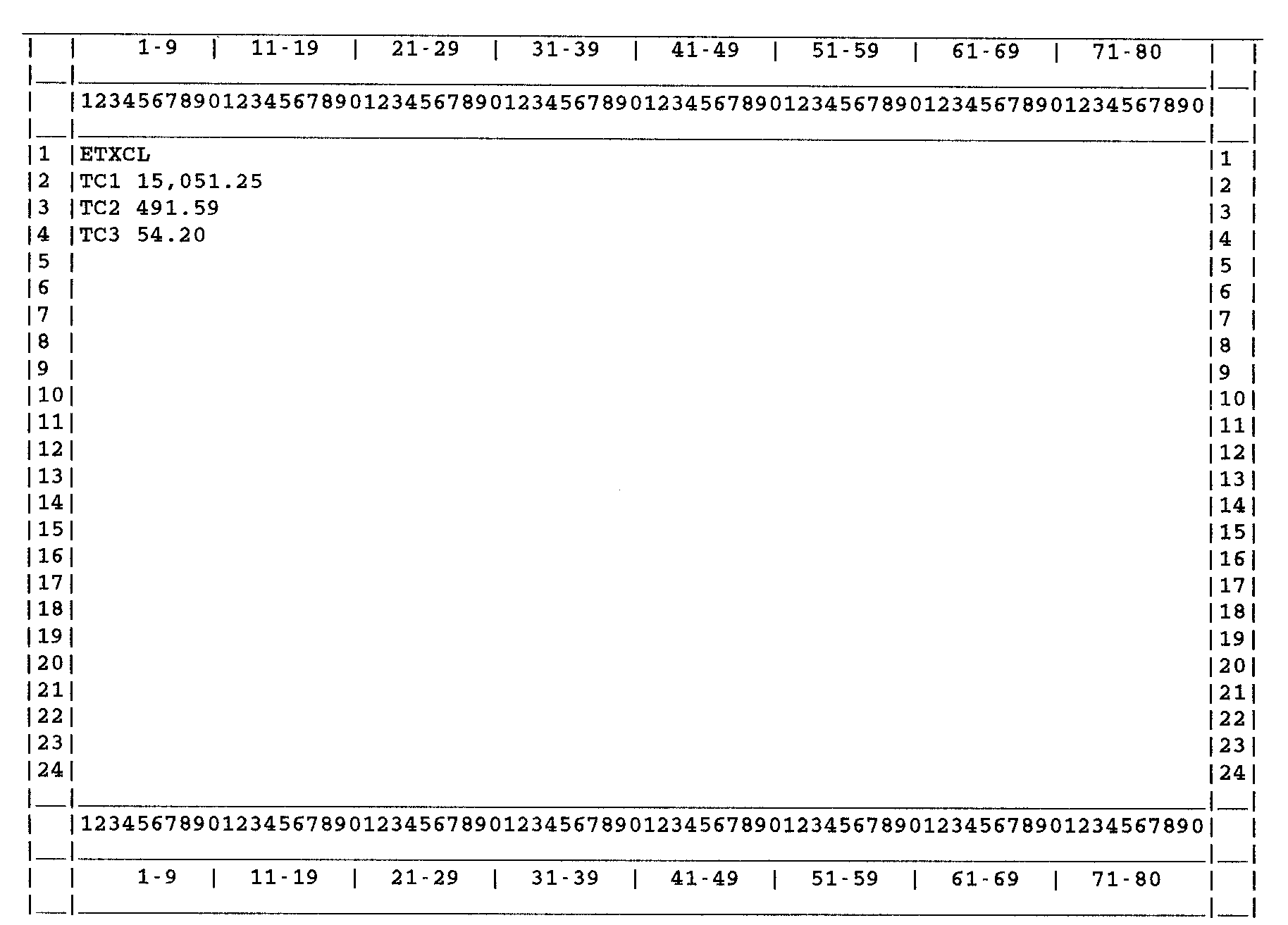
Please click here for the text description of the image.
Record Element Description:
| ITEM | LINE | POSITION | DESCRIPTION AND VALIDITY |
|---|---|---|---|
| 1 | 1 | 1–5 | Command Code ETXCL |
| 2 | 2 | 1–3 | Tax Class |
| 3 | 2 | 5–19 | Tax Class Amount |
| Note:If present, elements 2 and 3 may be repeated up to 7 times on lines 2 through 8. | |||
Screen Display:
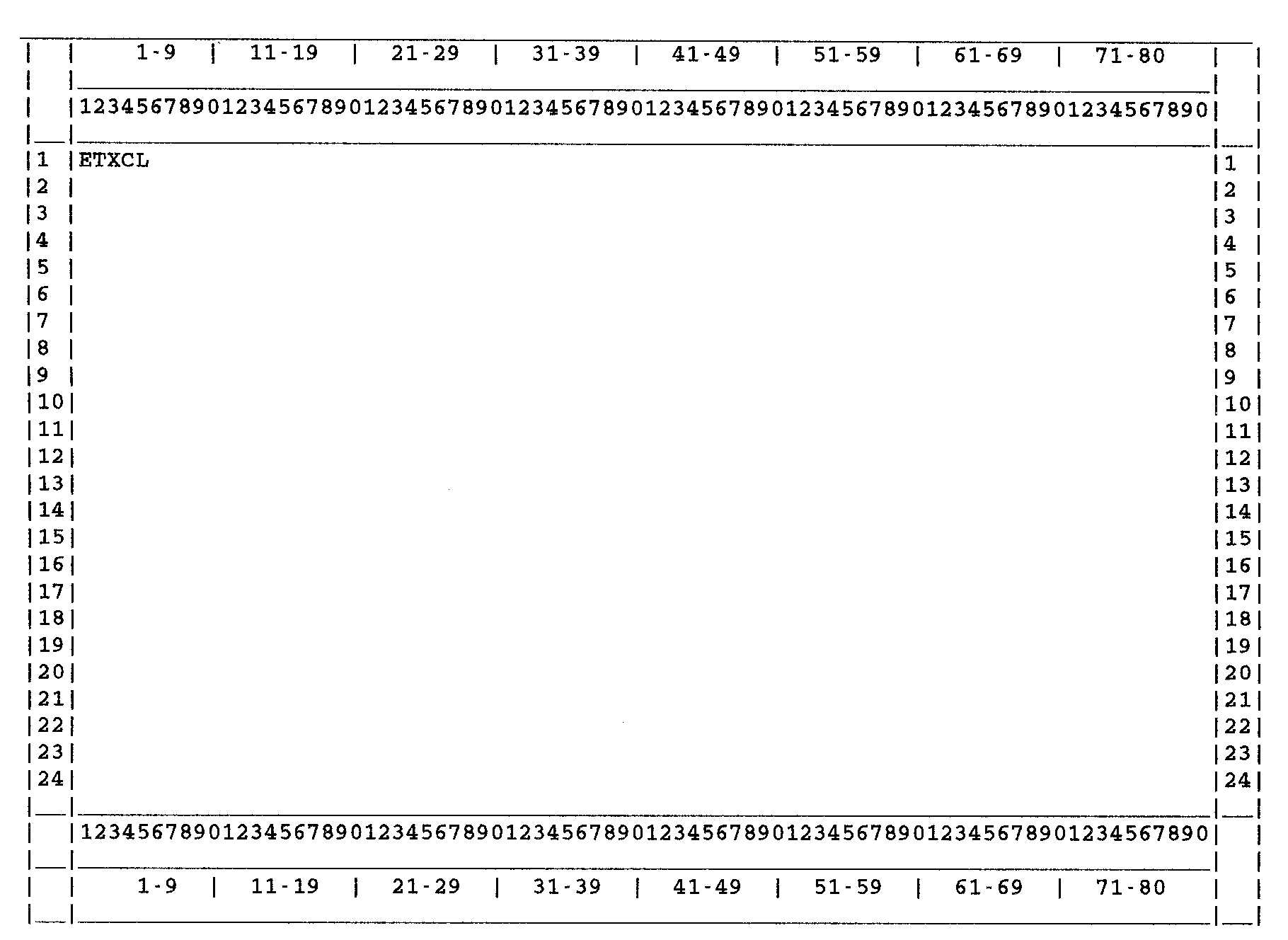
Please click here for the text description of the image.
Request Element Description:
| ITEM | LINE | POSITION | DESCRIPTION AND VALIDITY |
|---|---|---|---|
| 1 | 1 | 1–5 | Command Code ETXCL |
Screen Display:
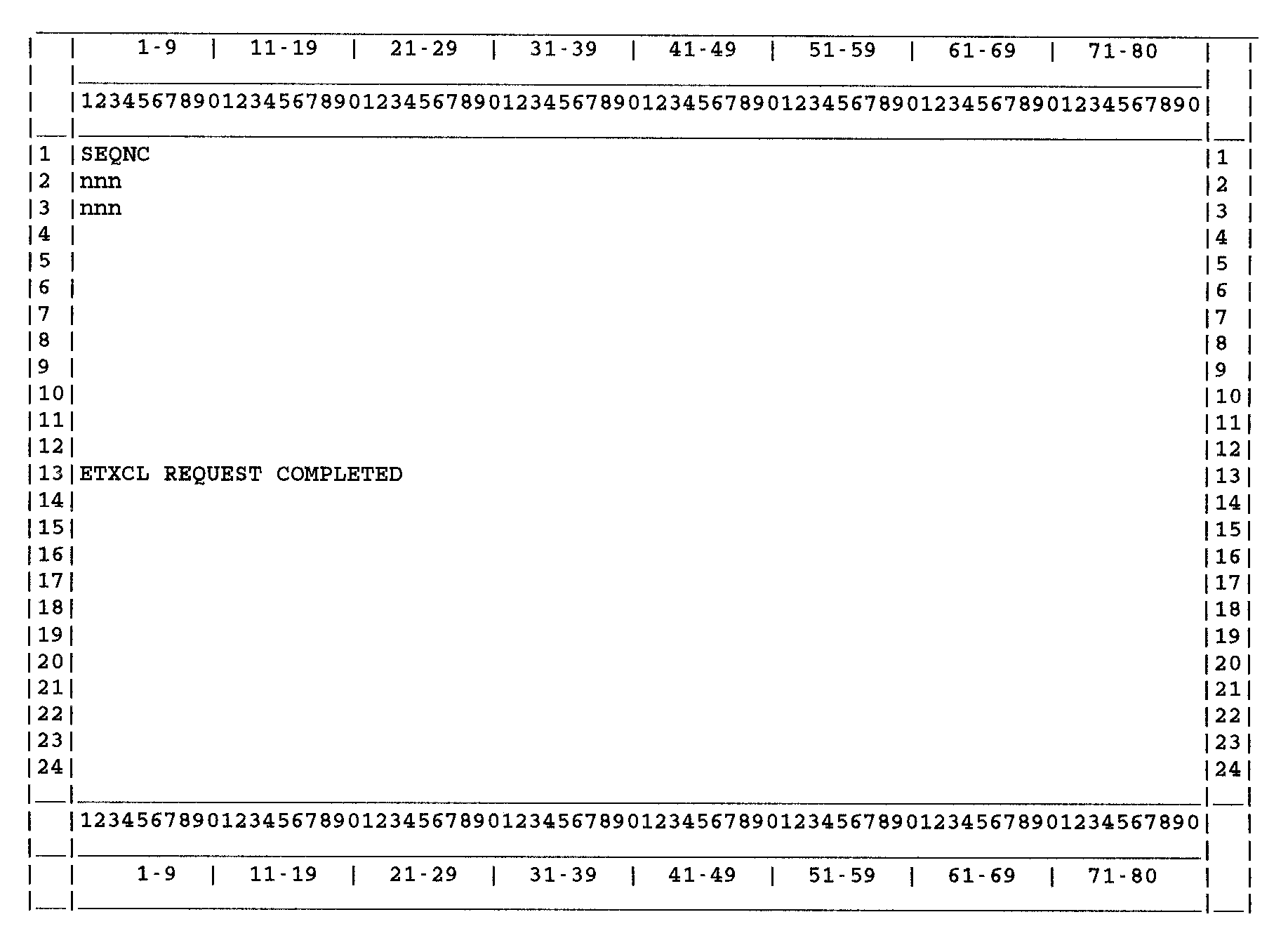
Please click here for the text description of the image.
The Record Element Description:
| ITEM | LINE | POSITION | DESCRIPTION AND VALIDITY |
|---|---|---|---|
| 1 | 1 | 1–5 | Command Code SEQNC |
| 2 | 2 | 1–3 | JULIAN DATE —Must be present. May not be earlier than the current Julian date unless the current Julian Date is between 363–366. In that case, the Julian Date may be between 001–004. |
| 3 | 3 | 1–3 | INPUT SEQUENCE NUMBER—Valid range is 000–999. Must be present. This is the last 3 digits of the Payment Sequence Number of the next payment to be input. |
Screen Display:
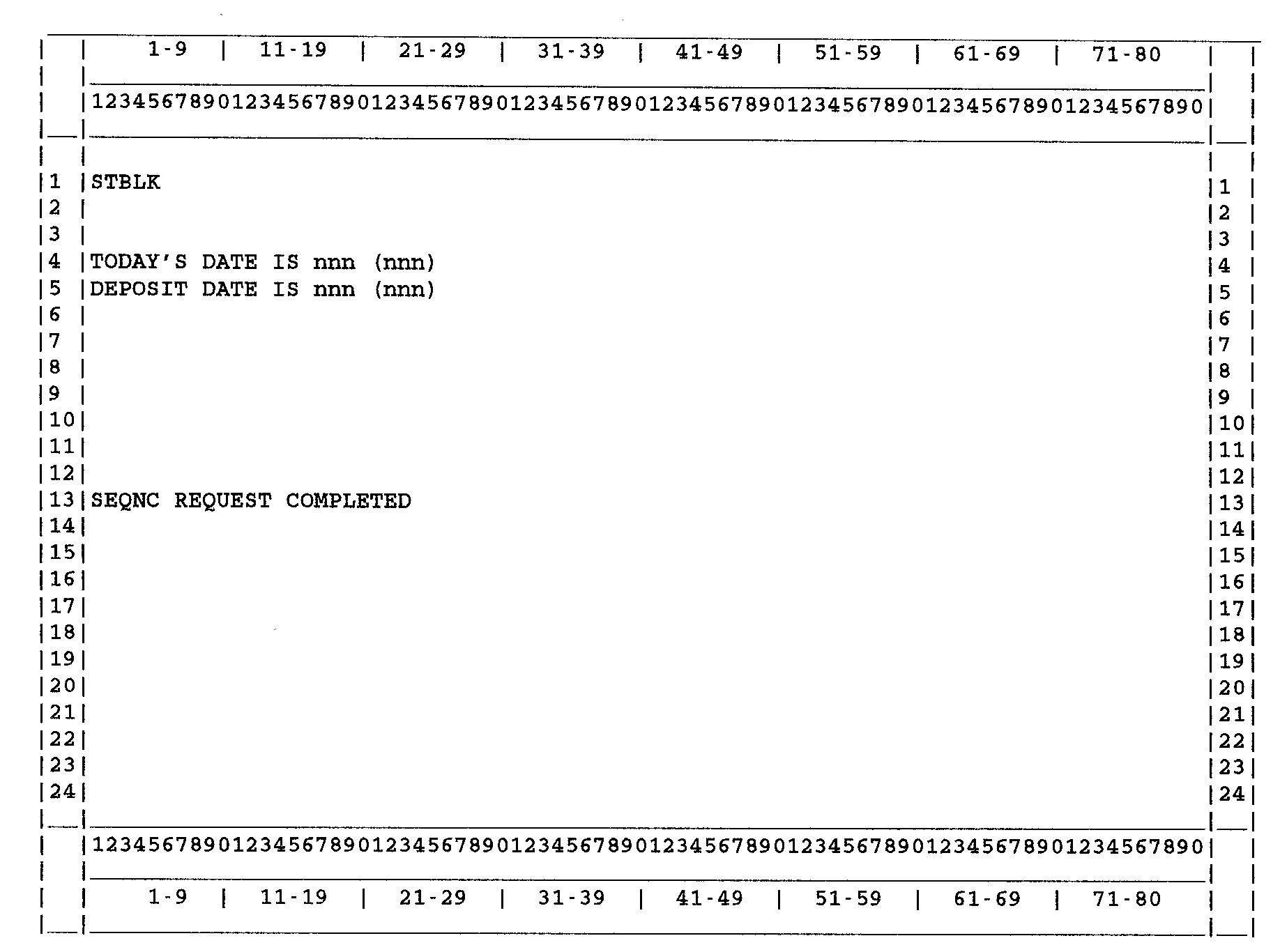
Please click here for the text description of the image.
Record Element Description:
| ITEM | LINE | POSITION | DESCRIPTION AND VALIDITY |
|---|---|---|---|
| 1 | 1 | 1–5 | Command Code STBLK |
| 2 | 1 | 13–19 | LITERAL "BEG SEQ " |
| 3 | 1 | 21–33 | PAYMENT SEQUENCE NUMBER—Payment Sequence Number to be assigned to the payment which begins the next block. Julian Deposit Date—3 digits—input District Office—2 digits—generated. Area Office—2 digits—generated Terminal Number—2 digits—generated. Operator Number—1 digit last digit of employee number generated. Sequence Number—3 digits—input. |
| 4 | 5 | 1–25 | Current Date message aaa = MON, TUE, WED, THR, FRI, SAT (day of week); nnn=corresponding Julian date. |
| 5 | 5 | 1–25 | DEPOSIT DATE message—aaa = MON, TUE, WED, THR, FRI (Day of week for deposit date) nnn—Deposit date from Item 3, Payment Sequence Number (first 3 digits). |
| 6 | 13 | 1–23 | Valid Response Message |
| Note:Date Messages—these messages displayed with a valid response for CC SEQNC are provided for operator confirmation. If erroneous deposit date was input, use CC ETXCL/SEQNC to set counters again and input correct deposit the date. If Today's date is incorrect, advise supervisor so that Service center may be contacted immediately. | |||
Screen Display:
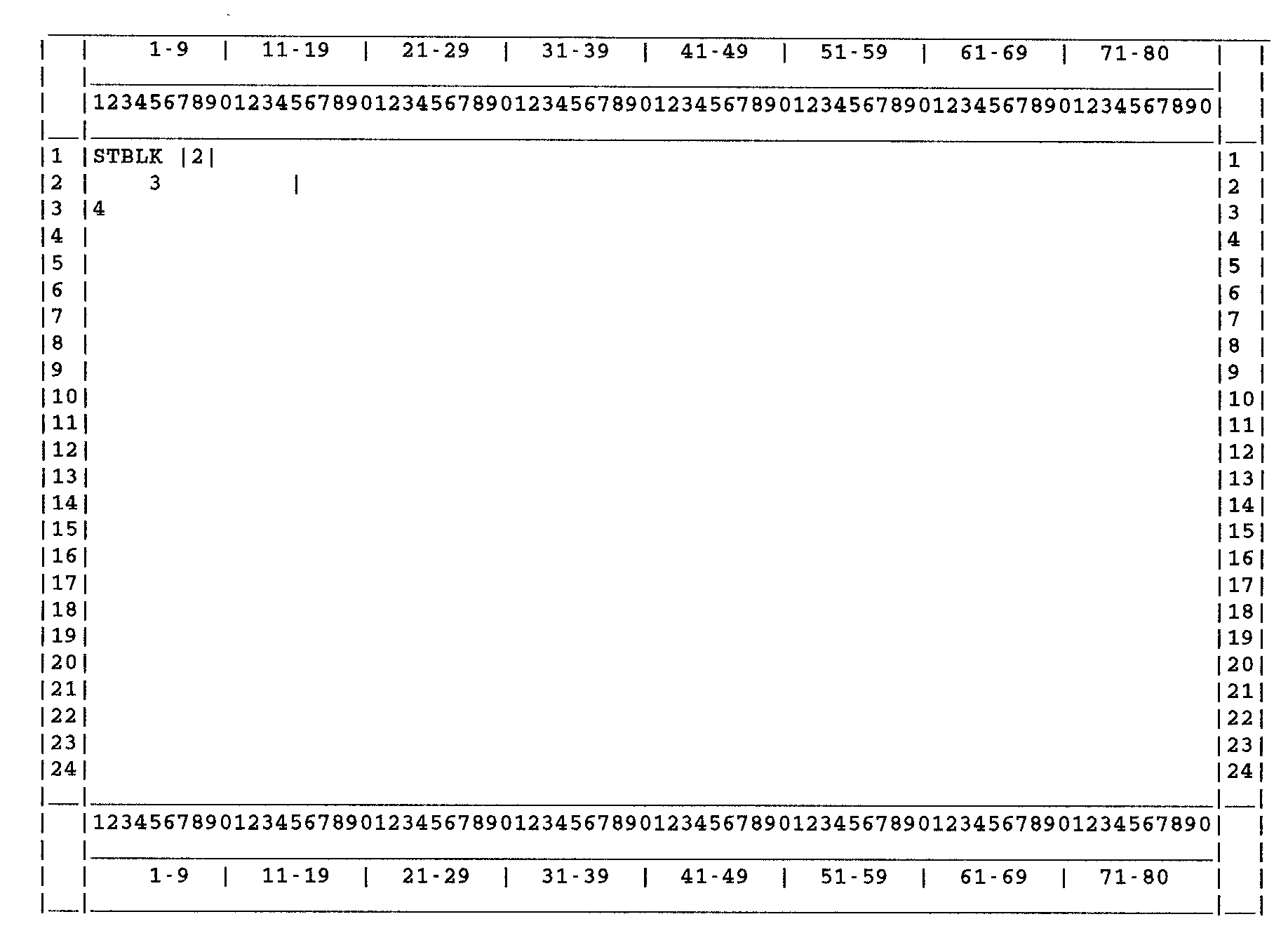
Please click here for the text description of the image.
Record Element Description:
| ITEM | LINE | POSITION | DESCRIPTION |
|---|---|---|---|
| 1 | 1 | 1–5 | COMMAND CODE STBLK |
| 2 | 1 | 7–8 | BLOCK COUNT —Number of counts in block (Valid Range 1b–20). |
| 3 | 2 | 1–14 | BLOCK AMOUNT —Must be a 3 to 14 character position edited amount field including decimal point and commas beginning in the first position of line 2. A comma in the first position is invalid. (Valid range .00 to 999,999,999.99). |
| 4 | 3 | 1 | TRANSACTION REGISTER INDICATOR—Must be blank or 1 (one). A one will prevent all items in the block from appearing on the Daily Transaction Register. |
Screen Display:
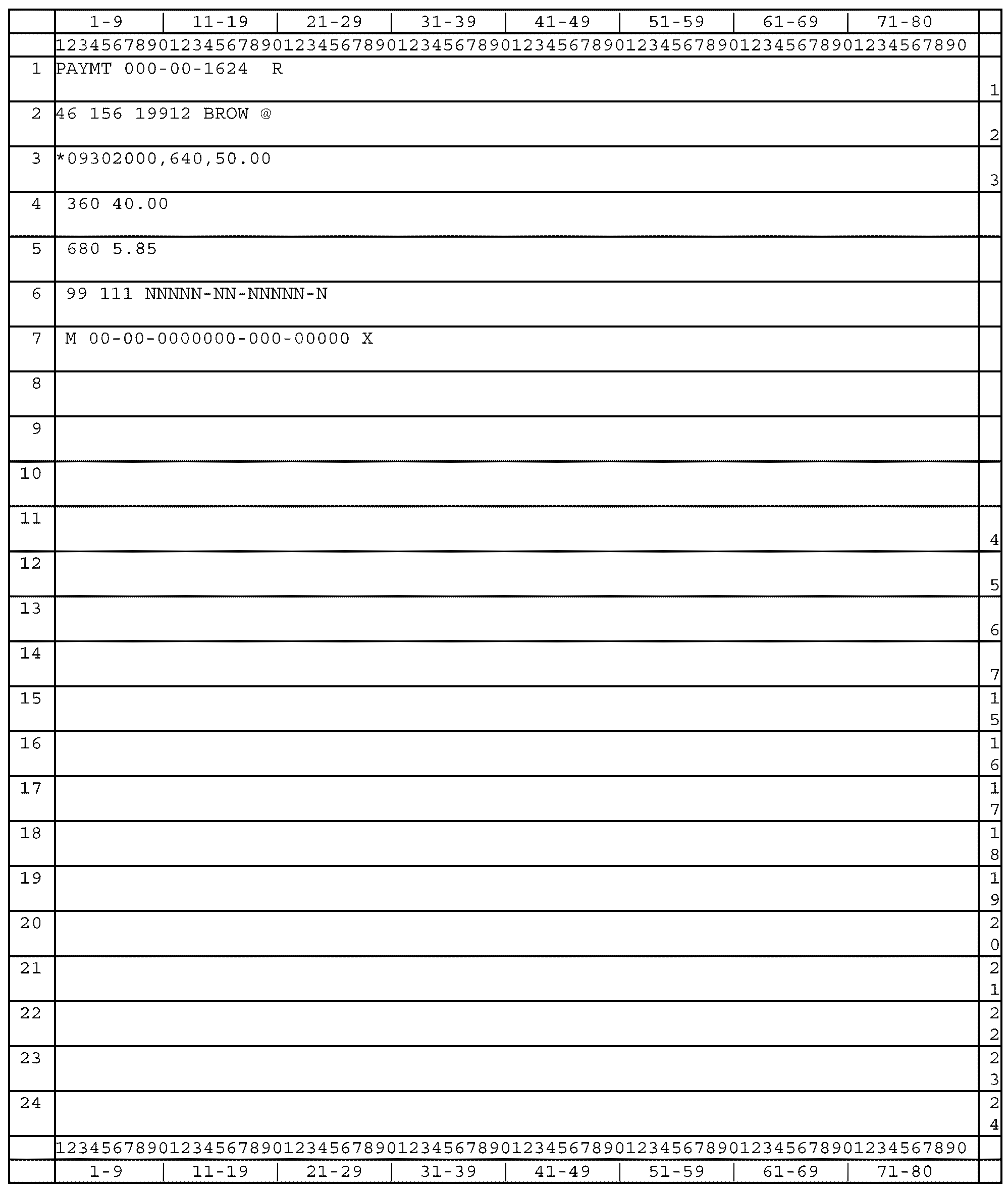
Please click here for the text description of the image.
Record Element Description:
| ITEM | LINE | POSITION | DESCRIPTION |
|---|---|---|---|
| 1 | 1 | 1–5 | Command Code PAYMT |
| 2 | 1 | 7–18 | TAXPAYER IDENTIFICATION NUMBER IMF: TIN must meet standard validity criteria. The last position must be either blank or an asterisk. Begin in position 2. |
| BMF: TIN must meet standard validity criteria. If the TIN is in EIN format the last two positions must be blank. If the TIN is an SSN format the last position must be V or W. Begin in position 2. | |||
| NMF: TIN must conform to rules for SSN except that the 12th position for an SSN will be N and the 11th position of an EIN will be an N. Begin in position 2. | |||
| IRAF: TIN must meet standard validity criteria. The last position must be P or X. Begin in position 2. | |||
| 3 | 1 | 20 | Screen Hold Code: must be R or blank. If R the input screen will be cleared from line 3 down upon completion of input. If blank the screen will be cleared from line 2 down. |
| 4 | 2 | 2–3 | MFT CODE—Must meet standard validity criteria. Begin in position 2. |
| BMF: with MFT code 46 or76: This criteria requires the Plan-Rpt-Num field to be recorded from tax module and displayed between MFT code and TAX PERIOD fields.Seeitem 5 below. | |||
| 5 | 2 | 5–7 | PLAN-RPT-NO—This field will represent the Plan number field for all MFT with the exception of MFT 76 BMF accountsthey have a special range of 000–999. This field will also represent a Report Numberfor MFT code 46for BMF accounts. Its range is 000, 100–999. the field is always numeric. Must be 000 filled or appropriate entry of Plan number or Report NumberSee Exhibit 2.4.15-7. |
| 6 | 2 | 9–14 | TAX PERIOD —Format YYYYMM. Must not be greater than the current date plus one year. For earliest return period for any MFT see IRM 2.3.8. For MFT 06 a payment is not valid before tax period 197812. For MFT 52 use tax period 000000. For MFT 07 a payment is not valid before tax period 198712. For MFT 46/76 tax period position will move over three position to allow for plan number or report number to be entered. |
| 7 | 2 | 16–19 | NAME CONTROL or CHECK DIGIT IMF/IRAF/BMF—Must meet standard validity criteria NMF—If the TIN is an SSN, the N/C must conform to the rules for IMF. If TIN is an EIN, the N/C must conform to the rules for BMF. The first two positions of the field must be blank, and the 3rd and 4th positions of the field must be letters of the alphabet other than E, G or M. |
| 8 | 2 | 21 | Non-IDRS indicator: Use (A) if TIN is not on TIF. Use @ if TIN is on TIF but the specific module is not. Otherwise position is left blank. |
| 9 | 3 | 1 | TRANS-DT-IND—lf after the first attempt of input for the Transaction Date an error occurs, the Asterisk (*) used as an error indicator can remain on the input screen to force the input of a date older than 7 days on the second attempt. |
| 10 | 3 | 2–9 | TRANSACTION DATE—Format MMDDYYYY. This date may not be later than the current day or earlier than the current date less seven days or equal to zeros. If the date of payment is the same as date of input, enter a comma instead of the actual date (which will be generated). Begin in position 2. Dates older than 7 days are accepted on correction input if the asterisk used as an error indicator is left on the screen. |
| 11 | 3 | 3–5 or 11–13 | PRIMARY TRANSACTION CODE—A comma (,) will be used if TC 670 (this would be two successive commas). |
| 12 | 3 | 4–16, 7–19, 10–22 or 15–27 | PRIMARY TRANSACTION AMOUNT—Must be a position field including decimal point and comma(s). Do not enter ($) signs. Begin after comma following or representing the transaction code. Enter .00 for a zero amount. Example of input of TC 670 with current day received date: 45.00 (begin in position 2). |
| 13 | 4 | 2–4 | SECONDARY TRANSACTION CODE—Secondary TC (penalty, lien fee etc.) is not a required input however, if secondary code is present it will be entered beginning on screen line 5, position 2. See Exhibit 2.4.15-8. |
| 14 | 4 | 6–18 | SECONDARY TRANSACTION AMOUNT—If item 13 is blank or 570, this field must be blank. If item 13 is 170,180 or 270, this field may be zero (designated by a zero in the left most position of this field). For all other Secondary TC's, an amount greater than zero must be present. An amount greater than zero follows the same rules as item 12 above. |
| 15 | 5 | 2–4 | TERTIARY TRANSACTION CODE—Tertiary transaction code is not required input. However, if a tertiary code is present it must be input beginning in screen position 2 on line 6. The 3-digit transaction code must be one of the Primary Transaction Codes Listed in item 10. No tertiary TC's for IRAF. |
| 16 | 5 | 6–18 | TERTIARY TRANSACTION AMOUNT—If present, must be greater than zero. Formatted as in item 12. |
| 17 | 6 | 2–3 | DESIGNATED PAYMENT CODE—Valid for IMF and BMF accounts only. See table for transaction code consistency checks must be input at all times. See Exhibit 2.4.15-9. |
| 18 | 6 | 5-7 | TAXPAYER ASSISTANT CENTERS—not required input, If not applicable, field should remain blank. |
| 19 | 6 | 9-22 | ORIGINAL ASSESSMENT DLN—Original assessment DLN is not a required input, however if present the transaction must be NMF and Primary Transaction Code must be 670, 680, 690 or 694. If present the field will only be validated for its format which is NNNNN-NN-NNNNN-N. |
| 20 | 7 | 2 | MULTIPLE SPLIT REMITTANCE INDICATOR—not required input, valid values M or S. If not applicable, field should remain blank. |
| 21 | 7 | 4-27 | TRACE-ID—It is mandatory that every Deposit Ticket (DT) and Deposit Voucher (DV) have a Trace ID number. Trace ID is a tracking mechanism to identify each DT with its corresponding payments and each DV with its corresponding debits. As of January 2008, all input payment systems automatically assign a 20-digit Trace ID number to each deposit ticket: • 14 digits for the Deposit Ticket • 20 digits for the individual payments associated with a Deposit Ticket (2) The Custodial Detail Database (CDDB) is an enhancement to the Financial Management Information System created to track all individual payments that comprise a deposit ticket and to balance the individual transactions against the deposit ticket totals which have been entered into the RRACS general ledger. The unique Trace ID will allow all payments to be identified and added to the CDDB. (3) The format of the Trace ID number is: Field Format Definition Epic Editor Unformatted Print: 49225T.sgm Printed Tue Dec 09 15:17:05 2008 User: C1KDB Page: 19 Site ID nn Campus file location code(FLC), Bank ID, or other Site ID System ID nn Defined Below Deposit Date YYYYDDD Julian Date Seq Number nnn For each deposit date,begin with 001 andincrement each additional Deposit by 1 Transaction Seq Number nnnnnn This field is relevant only for the Payment Transaction Record. For each payment summarized in a Deposit Ticket, beginning with 000001, sequentially increment the Transaction Seq Number for each transaction in the CDDB Detail Payment Record File. |
| 22 | 7 | 29 | TRACE-ID-IND—not required input, valid values X. If not applicable, field should remain blank. Allows all zeros in TRACE-ID field. |
Screen Display:
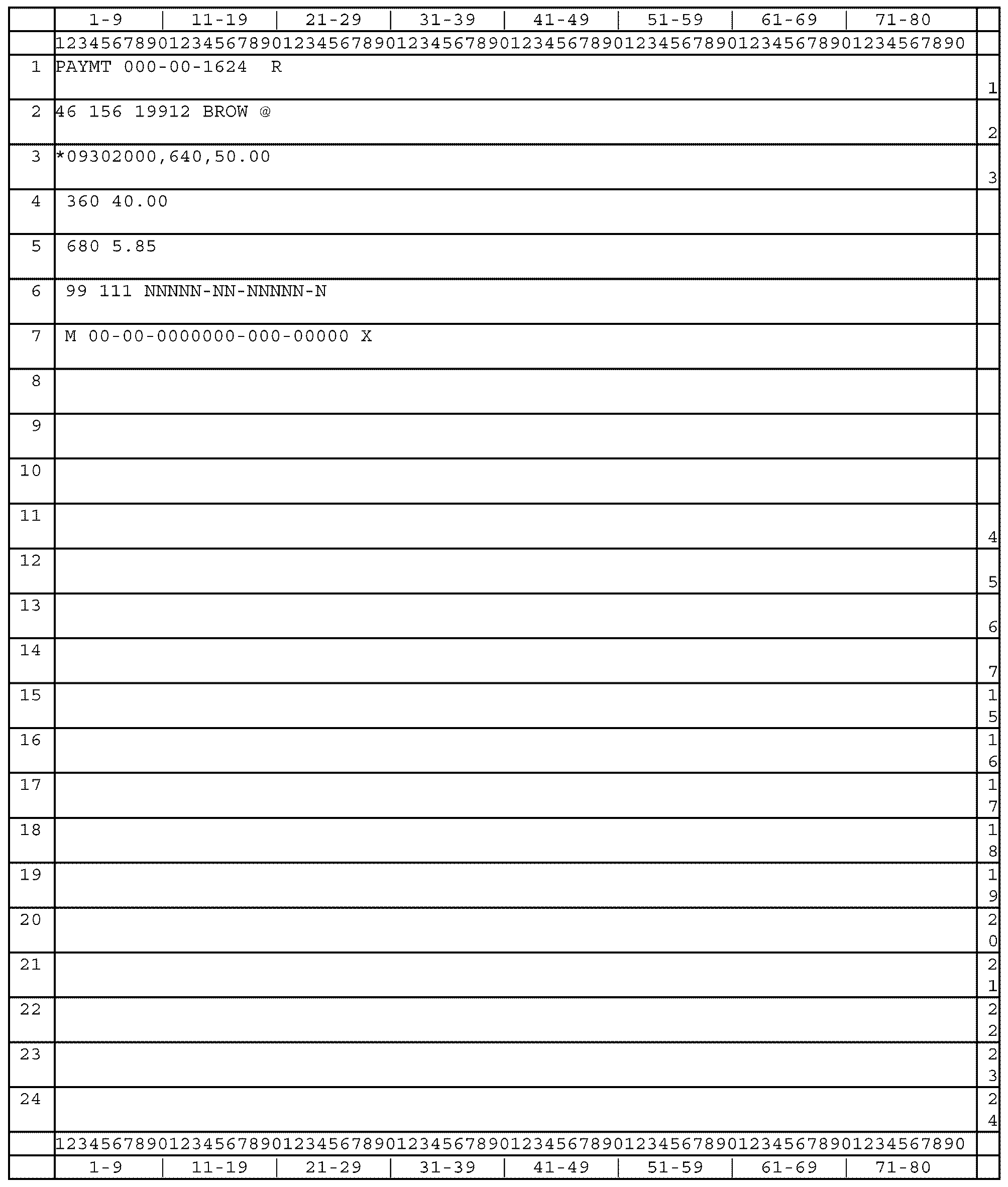
Please click here for the text description of the image.
Record Element Description:
Valid Primary Transaction Codes:
| Trans Code | Title | IMF | BMF | File IRAF | NMF |
|---|---|---|---|---|---|
| 640 | Advance Payment on Deficiency. NOTE: not valid for MFT 36 and 67. | X | X | X | |
| 660 | Subsequent Payment | X | X | X | X |
| 670 | Subsequent Payment | X | X | X | X |
| 680 | Designated Payment of Interest | X | X | X | X |
| 690 | Designated Payment of Penalty | X | X | X | |
| 694 | Application of Sale Proceeds | X | X | X | X |
CC PAYMT Input Display With Secondary Transaction Code
| Trans Code | Title | IMF | BMF | File IRAF | NMF |
|---|---|---|---|---|---|
| 170 | Estimated Tax Penalty | X | X | ||
| 180 | Deposit Penalty | X | |||
| 200 | TP Identifying No. Penalty | X | X | ||
| 270 | Failure to Pay Tax | X | X | X | X |
| 340 | Assessment of Interest | X | X | ||
| 360 | Fees and Costs | X | X | X | X |
| 570 | Additional Liability | X | X | X | X |
| Note:TC 170 is only valid for MFT codes 02, 05, 30, 33, 34, 44, 77 and 78. TC 180 is valid for MFT codes 01, 03, 09 ,10,11,12,77 and 78. TC 270 is not valid with MFT 06, 13, 36, 55 ,59 or 67 on any file. TC 340 is valid with all NMF MFT's except 59. For BMF, TC 340 is valid only with MFT 05,15, 52, 58, 60, 77 and 78. TC 680 must be accompanied by a secondary TC 340 for all NMF MFT's except 59. |
Designated Payment Code Transaction Consistency Checks:
| TRANSACTION CODES | 610 | 640 | 660 | 670 | 680 | 690 | 694 | VALID MFT(s) |
|---|---|---|---|---|---|---|---|---|
| DESIGNATED PAYMENT CODES | 00 | 00 | 00 | 00 | 00 | 00 | ALL | |
| 01 | 01 | 01 | 01 | 01 | IMF(55), BMF (01,03,09,11, OR 12) | |||
| 02 | 02 | IMF(55), BMF (01,03,09,11, OR 12) | ||||||
| 03 | 03 | 03 | 03 | ALL | ||||
| 04 | ALL | |||||||
| 05 | ALL | |||||||
| 06 | 06 | 06 | 06 | 06 | ALL | |||
| 07 | 07 | 07 | 07 | ALL | ||||
| 08 | ALL | |||||||
| 09 | 09 | ALL | ||||||
| 10 | ALL | |||||||
| 11 | ALL | |||||||
| 12 | ALL | |||||||
| 13 | 13 | 13 | 13 | 13 | MFT must be 30 and restricted to tax period 199312–199411 transactions | |||
| 14 | 14 | 14 | 14 | 14 | ALL | |||
| 19 | ALL | |||||||
| 20 | ALL | |||||||
| 21 | ALL IMF AND BMF (01,03,10,11,12 OR 13) | |||||||
| 22 | IMF(30,55) AND BMF (01,10,31) | |||||||
| 23 | IMF(30,55) AND BMF (01,10,31) | |||||||
| 36 | 36 | IMF (35) | ||||||
| 43 | BMF (43) | |||||||
| 54 | ALL | |||||||
| 76 | ALL | |||||||
| 99 | 99 | 99 | 99 | ALL |
| Note: | (1) Designated Payment Codes 15–20, 22-33, 37-42, 47-51,53, 55-60 and 63–98 are not valid for CC PAYMT. |
| (2) For Designated Payment Codes 01 and 02 IMF accounts MFT must be 55. | |
| (3) For Designated Payment Codes 01 and 02 BMF accounts MFT must be 01, 03, 09, 11 or 12. | |
| (4) For Designated Payment Code 13 the MFT must be 30 and restricted to Tax Period 9312–9411 transactions. | |
| (5) For Designated Payment Codes other than 01, 02 or 13 the MFT may be any valid MFT Code. Designated Payment Code input of 01 or 02—Transaction must be IMF and MFT Code 55 or BMF and MFT Code or 01, 03, 09, 11 or 12. Designated Payment Code input of 03 or 04 or 05—Transaction must be IMF or BMF. | |
| (6) For designated Payment Code 12 is only allowed with Primary Transaction Code 640 (advance payment of determined Deficiency or Under-reporter proposal). | |
| (7) For designated Payment Code 21 is only for transaction 670 transaction must be IMF or BMF with MFT of 01, 03, 10, 11, 12 or 13. | |
| (8) For designated Payment Code 54 is only for Primary Transaction Code 670, transaction must be IMF. | |
| (9) For designated Payment Code 33-35 is allowed with Primary Transaction Code 670,671 and 672. | |
| (10) DPC 05-07, 16, 18-23, 30,32 and 43 not valid with Primary Trans Cd 640, 670. Must be IMF account. MFT must be 35. | |
| (11) DPC 43 is allowed with Primary Trans Cd 640. Must be BMF account. MFT must be 43. | |
| (12) DPC 05-07, 16, 18-23, 30,32 and 43 not valid with Primary Trans Cd 640, 670. Must be IMF account. MFT must be 65. | |
| (13) DPC 73 Valid for Primary Transaction Code 640, 670, 680. Must be IMF or BMF account. MFT 02, 05, 06, 30. | |
| (14) For designated Payment Code 76 is only for Primary Transaction Code 670, and the FILE SOURCE CD I is 1 and MFT of 30 or FILE SOURCE CD I is 2 and MFT of 02, 05, 06 or 34 |
Screen Display:
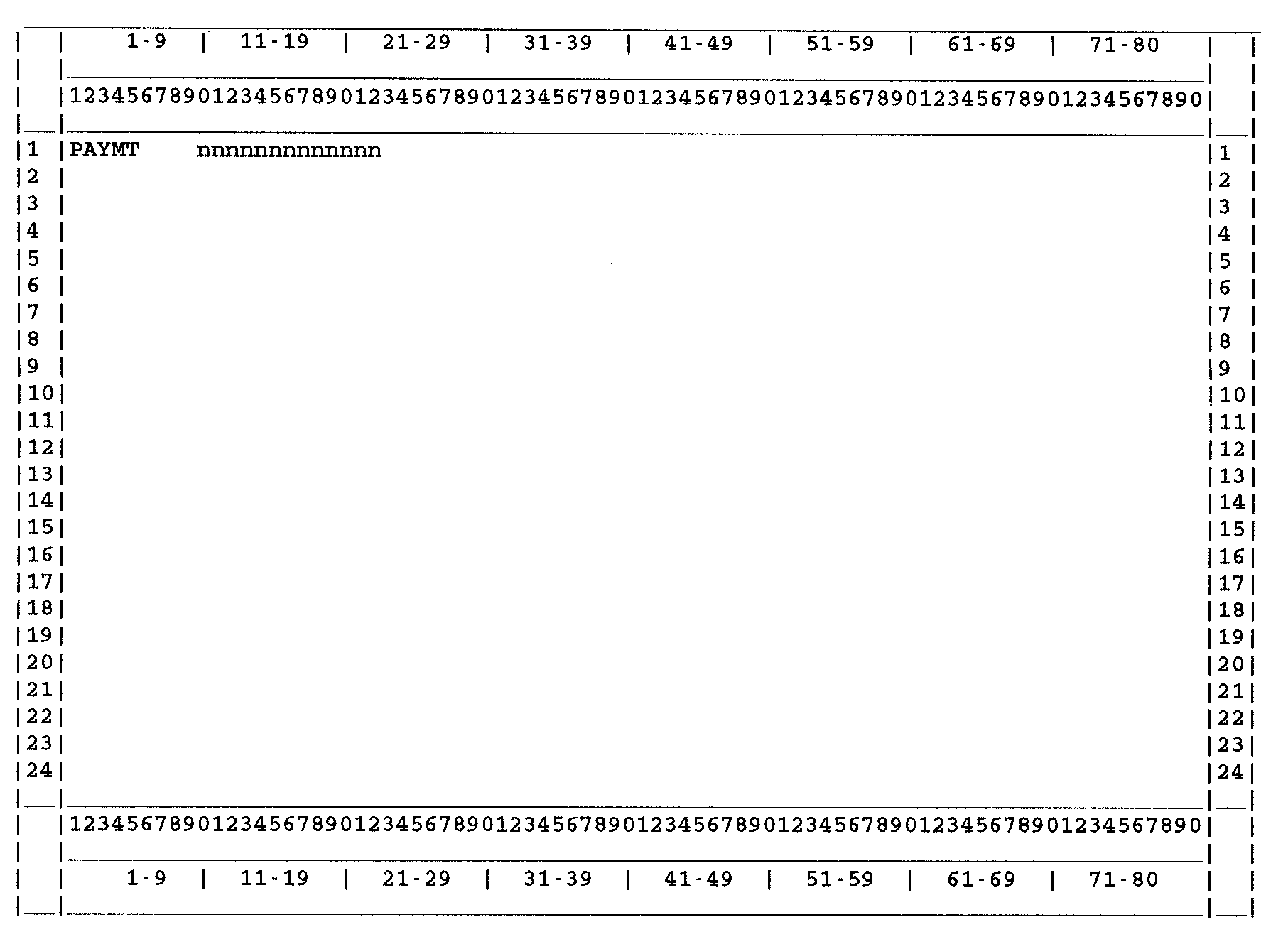
Please click here for the text description of the image.
Record Element Description:
| ITEM | LINE | POSITION | DESCRIPTION |
|---|---|---|---|
| 1 | 1 | 1–5 | Command Code PAYMT |
| 2 | 1 | 10–22 | Payment Sequence Number |
Screen Display:
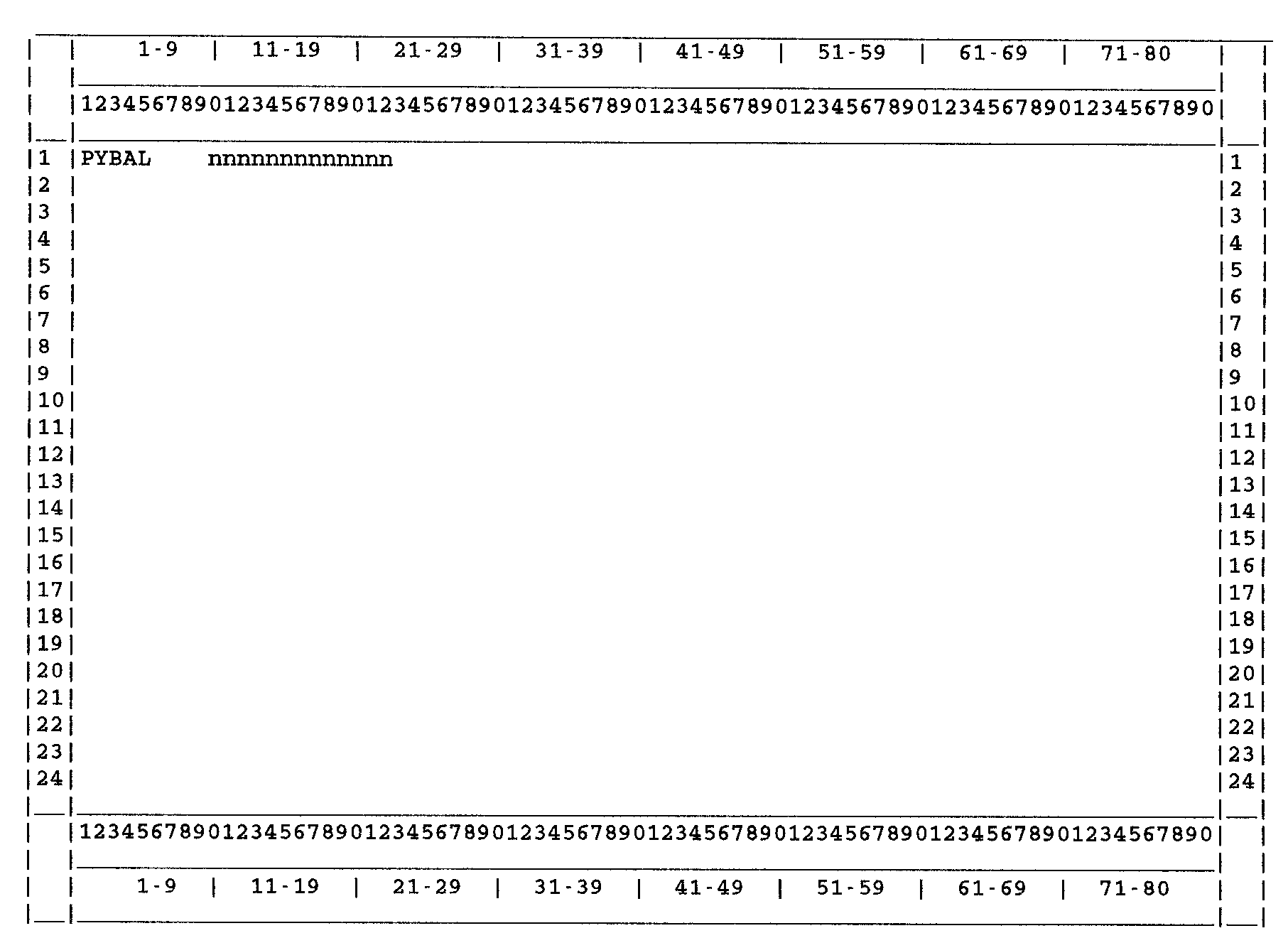

 )
or https:// means you've safely connected to the .gov website. Share sensitive information only on official, secure websites.
)
or https:// means you've safely connected to the .gov website. Share sensitive information only on official, secure websites.
